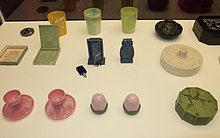Preparation of Urea-Formaldehyde Resin
Preparation of Urea-Formaldehyde Resin

Preparation of Urea-Formaldehyde Resin
Urea-formaldehyde is also called urea-methanal and is named so for its common synthesis pathway and overall structure. It is a non-transparent thermosetting resin or plastic which is made from urea and formaldehyde when they are heated in the presence of a mild base such as ammonia or pyridine. These resins are commonly used in adhesives, finishes, and molded objects as shown in the picture alongside. Urea-formaldehyde resin was first produced in 1884 by Hölzer, who was working with Bernhard Tollens.
A class of synthetic resins called Urea-formaldehyde resin is obtained by chemical combination of urea (a solid crystal obtained from ammonia) and formaldehyde (a highly reactive gas obtained from methane). Urea-formaldehyde resins are used mostly as adhesives for the bonding of plywood, particleboard, and other structured wood products.
Production Steps
The synthesis of a urea-formaldehyde resin occurs in two stages. In the first stage of production, urea is hydroxymethylolated by the addition of formaldehyde to the amino groups. This reaction is i a series of reactions which lead to the formation of mono-, di-, and trimethylolureas. Tetramethylolurea is apparently not produced, but atleast not in a detectable quantity.

The addition of formaldehyde to urea takes place over the entire range of pH. The reaction rate depends on the pH. The rate for the addition of formaldehyde to urea is successively form one, two, and three methylol groups which has been estimated to be in the ratio of 9:3:1, respectively.The exact ratio depends on the reaction conditions employed in the addition reaction.
The second stage of urea-formaldehyde resin production includes the condensation of the methylolureas to low molecular weight polymers. The rate at which these condensation reactions occur is very dependent on the pH and, for all practical purposes depends on only atacidic pHs. The increase in the molecular weight of the urea-formaldehyde resin under acidic conditions is a combination of reactions leading to the formation of:
- methylene bridges between more amido nitrogens by the reaction of methylol and amino groups on reacting molecules (a);
- methylene ether linkages through the reaction of two methylol groups (b);
- methylene linkages from methylene ether linkages through the splitting out of formaldehyde (c);
- methylene linkages through the reaction of methylol groups splitting out water and formaldehyde in the process(d).

ALTERNATE METHOD:
In alternate production of urea resins are made by the condensation of formaldehyde and in an aqueous solution, using ammonia as an alkaline catalyst. This condensation reaction leads to the formation of a colourless, syrupy solution that can be spray-dried to a powder and can be used later use in coatings or adhesives; it can also be mixed with cellulose filler which produce powders for molding into solid objects. Due to the influence of heat and pressure, the resin at this point is made up largely of low-molecular-weight intermediate polymers or prepolymers and is cured to its final state, which consists of a three-dimensional network of interlinked polymers.
SOME RELATED QUESTIONS
Q1. What is a thermosetting resin?
Ans. A thermosetting substance is one which liquifies at high temperatures, then it is molded into a fixed shape and then cooled. This shape obtained after cooling is permanent, meaning that the substance will not liquify on re application of heat.
Q2. Mention a few applications of urea-formaldehyde resin.
Ans.These resins are used in adhesives for the bonding of plywood, particleboard, and other structured wood products, finishes and molded objects.
Q3. How many products are formed in the 1st stage of production?
Ans. In general there forms one, two, and three methylol groups in the ratio of 9:3:1, respectively. The exact ratio however depends on the reaction conditions employed in the addition reaction.
For further more articles visit www.oureducation.in and blog.oureducation.in
Tell us Your Queries, Suggestions and Feedback
3 Responses to Preparation of Urea-Formaldehyde Resin
« Career at Aricent with Placement Guidelines for Aricent Active Power Of Electrical Circuit Analysis »




PROCEDURE FOR THE SYNTHESIS OF UREA FORMALDEHYDE
percentage urea to formaldehyde and temperature reaction with pH